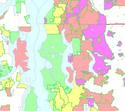According to the results of the 2010 census, Shanghai's population was nearly 1,000,000 people more than had been projected by local authorities. The provincial level of jurisdiction grew from a population of 16.4 million in 2000 to 23.0 million in 2010. Shanghai is one of the world's fastest growing megacities (urban regions of more than 10 million population). read more »
Urban Issues
Will the Last Family Leaving Seattle Please Turn out the Lights?
New Census data for the Seattle area's population changes, 2000-2010, permit a preliminary look at age and at types of households in the region. Let's look at patterns of geographic variation in selected age groups and household types for places in greater Seattle. It provides more evidence for how rapidly Seattle in particular is changing in fundamental ways. read more »
Why Compact Cities Aren't so Smart
I was interested to read the views of Rick Boven of the New Zealand Institute about central and local government needing to resolve their differences about the future of Auckland. Well, they have worked on that since the establishment of GUEDO in 2005 (now the Auckland Policy Office). read more »
The Other China: Life on the Streets, A Photo Essay
We all know or have heard about the overwhelming development going on in China. Journalists enthuse and analysts throw magnificent statistics of what seems to be a miracle. Yet there is little discussion of the daily life of the common people, and their struggle. There are miracles aplenty in China, but the astounding figures only partially reflect the reality. read more »
California’s Green Jihad
Ideas matter, particularly when colored by religious fanaticism, wreaking havoc even in the most favored of places. Take, for instance, Iran, a country blessed with a rich heritage and enormous physical and human resources, but which, thanks to its theocratic regime, is largely an economic basket case and rogue state. read more »
Orlando’s Sunrail: Blank Checks Induced by Washington
We are supposedly living in an age of austerity, but many federal programs are leading many states into overspending and potential fiscal insolvency. Transit spending is a case in point, as is indicated by the proposed Orlando Sunrail commuter rail project. read more »
UN Celebrates Seven Billion People a Year Too Early
The UN has decided to announce that on October 31, 2011 the Earth’s human population will pass the seven billion mark, up from the six billion that was designated on December 5, 1998. The United Nations Population Division Agency is the main organization that estimates global population. Every two years, their report attempts to piece together surprisingly fragmentary national census data and demographic surveys to arrive at a global estimate. As a geographer, I have long been interested in these reports, and in all aspects of population change and distribution on the earth. read more »
- Login to post comments
Inside Sydney's Central Business District: the Retail Core
World famous for its beautiful harbour setting, Sydney’s Central Business District is undergoing a resurgence. As the hub of Australia’s finance sector, it stumbled during the global crisis. Office vacancies jumped from 5.7 per cent in early 2008 to 8.8 per cent in mid 2009, despite stable supply. Ultimately, though, Sydney was spared the worst, owing to its rise as a staging post for trade and investment in the Asia-Pacific region, which averted the havoc of Europe and North America. Recovery is now underway, if slowly. read more »
Listing the Best Places Lists: Perception Versus Reality
Often best places lists reflect as much on what’s being measured, and who is being measured as on the inherent advantages of any locale. Some cities that have grown rapidly in jobs, for example, often do not do as well if the indicator has more to do with perceived “quality” of employment. read more »
Orlando: Uncle Sam Meets Mickey Mouse
Hawks and doves disagree on whether World War II ended the Great Depression. Depending on which species of bird squawks louder, military spending may be the only way out of our current financial malaise. In many ways it is already happening, although it is a surreptitious and quiet influence felt mostly in the high-tech economic sector. Defense growth in one of the most unlikely places – Orlando, Florida – has already begun to diversify the region’s income stream, create a new urban c read more »





















